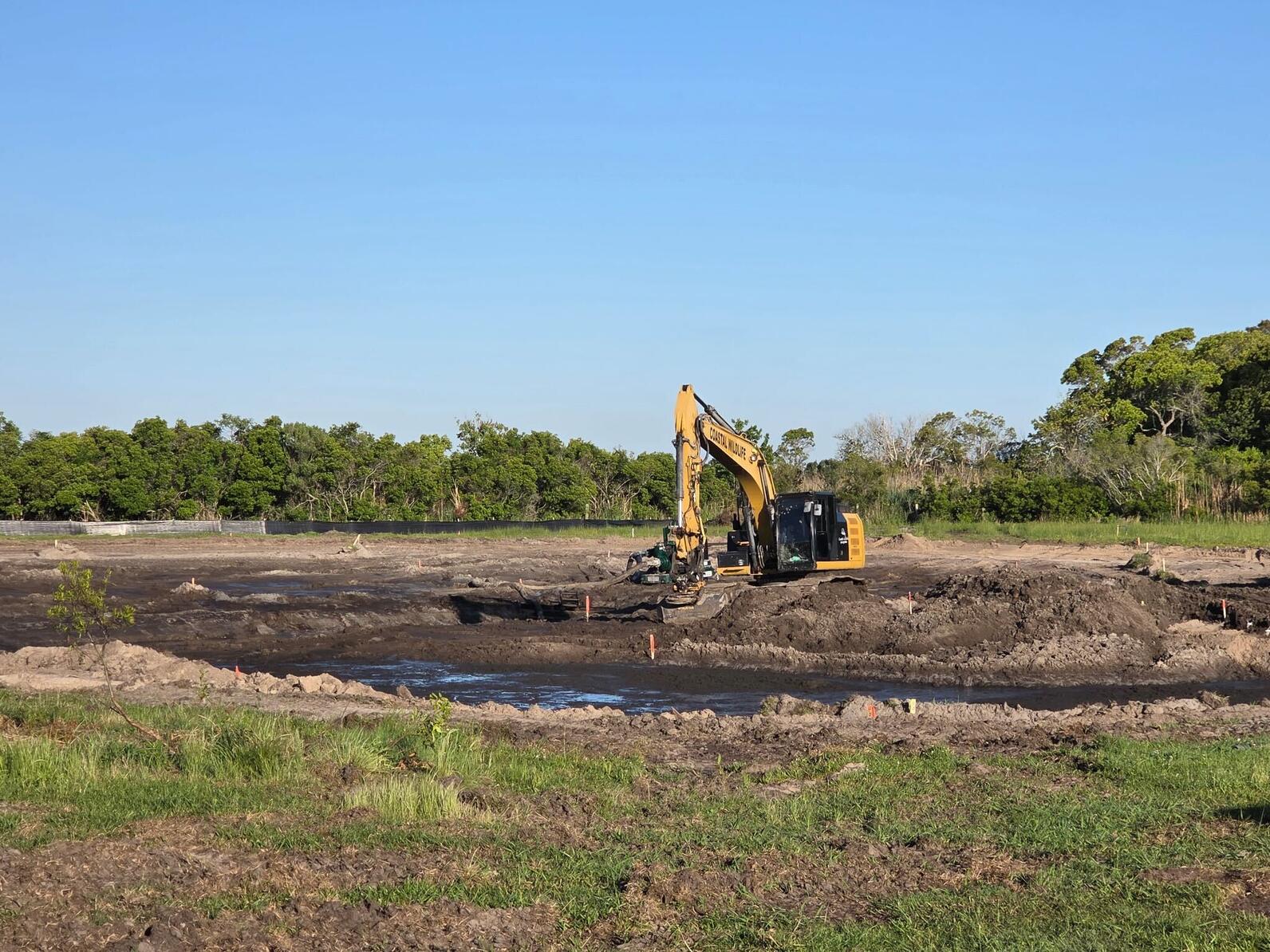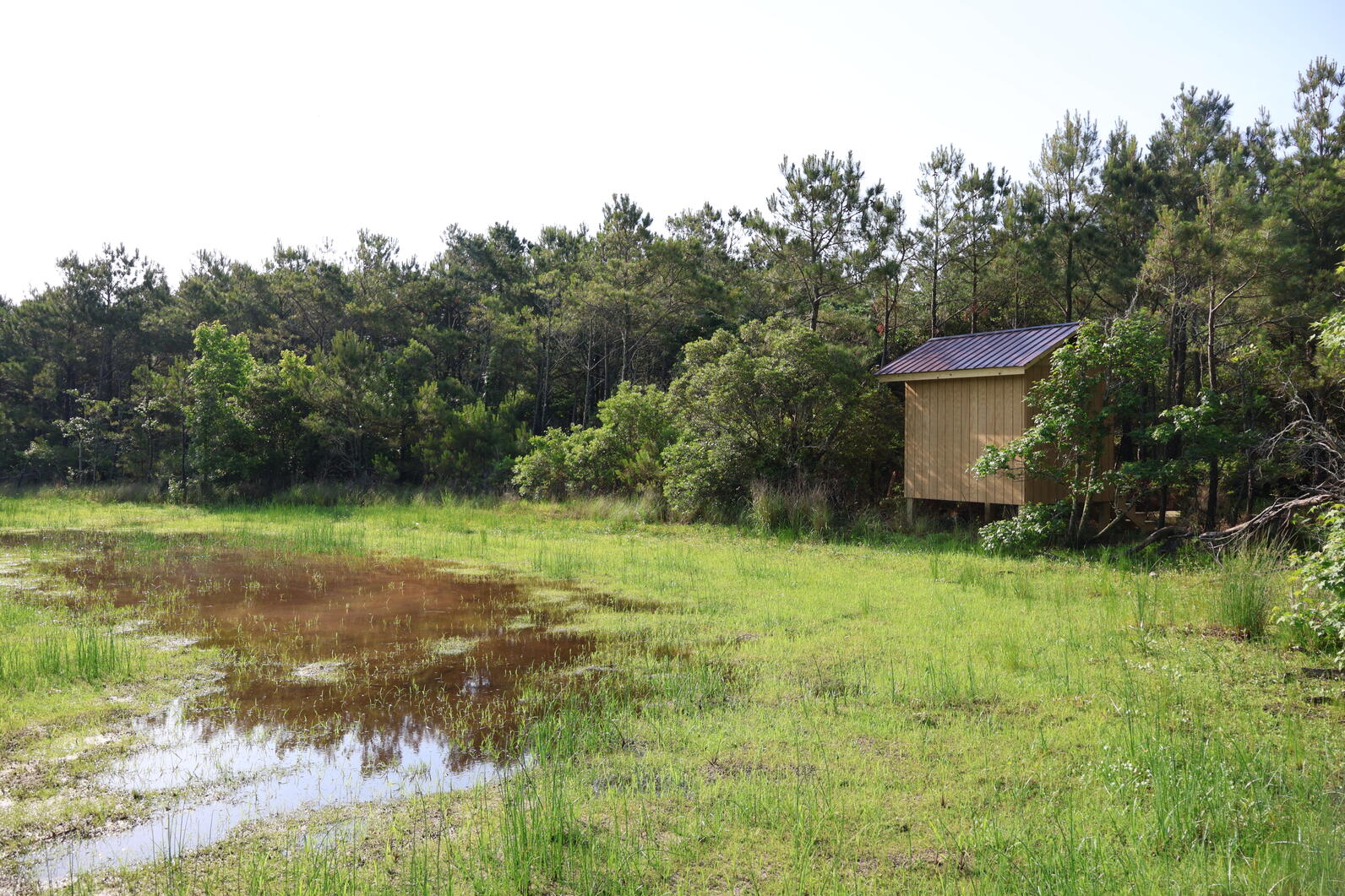It’s been a busy year at the Donal C. O’Brien Jr. Sanctuary at Pine Island, full of exciting new projects and the return of breeding birds. Thus far in 2025, we’ve made important progress on several major habitat restoration projects and wildlife surveys, all while welcoming the return of spring migrants.
Read on for a full recap of what we’ve been up to across Pine Island’s 2,600 acres of marsh and upland maritime forest.
Habitat Reconstruction
The biggest change has been a major restoration project to reconstruct a prominent bulkheaded impoundment in the heart of the sanctuary. Thanks to a $309,000 grant from North Carolina’s Land and Water Fund, we spent the spring tearing out the wooden edges of the pond and reconnecting it to the marsh. The next task has been replanting the edges with native rushes and other vegetation.
Soon there will be continuous waterflow throughout the whole system, allowing fish and other critters to expand their use of the sanctuary from the pond to the marsh and the sound. While there is still work left to be done, we’re already seeing birds return to the restored banks.

“The birds began using the pond edges right away, which is always encouraging,” said Robbie Fearn, director of the sanctuary. “We’re already seeing herons and migratory shorebirds foraging in the flats and Osprey bathing in the water. We’re hoping to see more ducks and other wildlife utilizing it in the near future."
Managing Impoundments for Black Rails
This year we also continued a new project to provide suitable habitat for breeding Black Rails. This tiny, secretive marsh bird is now federally classified as a threatened species, with only a tiny population remaining in North Carolina.
We’re using a pump system—powered by solar panels—to control water levels and vegetation at an impoundment, creating ideal conditions for young rail pairs looking to establish a breeding territory. With their short legs and particular nesting and foraging habitat, Black Rails depend on wet, grassy habitat that floods infrequently.
The infrastructure has been installed, now we’re gathering baseline data and tweaking the irrigation system to find the sweet spot for Black Rails.
Wildlife Surveys
In spring, during early mornings and late evenings on the marsh, you might hear the muffled grunts, squawks, and chuckles of secretive marsh birds like Virginia Rail, King Rail, Least Bittern, and Common Gallinule.
That’s when our team heads deep into the marsh to listen for these calls and record where and how many there are. Every year we visit the same spots so we can monitor their population over time.
The data gathered from the surveys goes towards the National Inventory of Marsh Birds coordinated by the U.S. Fish and Wildlife Service. We’re also using the data to establish a baseline of what birds occupy areas near our four marsh restoration pilot projects so we can see how bird populations respond.
Similarly, the Pine Island team also conducted Night Jar surveys this spring, helping to gather data about this enigmatic, nocturnal family of birds that includes Chuck-will's-widows. The surveys take place during a five-day window centered around full moon.
“Because these birds are so secretive you really have to catch them at the perfect time to be able to accurately record the ones we have onsite,” said Sara Marschhauser, senior coordinator of habitats and facilities at Pine Island. “It’s always very gratifying to hear their calls and know that the management we’re doing at the sanctuary is working.”
We've also been contributing data to the Box Turtle Connection. Eastern Box Turtles are a vulnerable species in North Carolina and can tell us a lot about the health of the habitats in which they reside. Marschhauser began marking individuals last May and put out three radio telemetry transmitters last fall. These radio telemetry tags have helped us keep tabs on them as they roam around the sanctuary.
Nesting Birds
In February, the team put up new Purple Martin gourds, after the birds failed to have much nesting success the last two breeding seasons. That’s due in part to a pair of Ospreys nesting on the lodge’s chimney, which would somtimes perch on the old martin houses. A small flock arrived in May and have already started nesting in the gourds.
Volunteers also installed a Purple Martin house on different portion of the sanctuary, donated by long-time bird lover and supporter Linda Sexton. We are extremely grateful for this donation, which will provide the perfect multiple-room housing structure for a colony of Purple Martins or Tree Swallows.

Speaking of the Ospreys, they returned to nest on the chimney of the lodge for the third year in a row. They’ve already hatched two chicks, who have been poking their heads out of the nest to get a glimpse of the world around them.
Marsh Restoration
Over the last 50 years, Pine Island marshes have receded by more than 300 feet in some areas. Thanks to funding from the National Fish and Wildlife Foundation’s National Coastal Resilience Fund, we’re undertaking a series of marsh restoration pilot projects that will address this loss while determining if similar solutions could work for surrounding communities.
We’ve continued to make important strides on four projects, which include using Christmas trees and coir logs to reduce erosion and rebuilding the marsh with thin-layer sediment placement.
We are nearing permits on the shoreline stabilization sites and are still working through permitting on the two thin layer sediment sites, with the goal of starting work on some of the projects next spring.
“It’s a long process but we’re hopeful that our careful and detailed planning will produce countless benefits for birds and people,” said Senior Program Manager for Coastal Resilience Cat Bowler.
New Installations
With funding from Dominion Power, Pine Island got its first ever Motus Tower. We’re still working to permanently place the tower, but the infrastructure is set up. We’re hoping to eventually place another one on the west side of the sanctuary so we can pick up the signals of a wider variety of migrants.

We’ve also completed the installation of a new photo blind, with help from the Albermarle chapter of the National Wildlife Federation. It will be the perfect spot for partners and researchers to get a behind-the-scenes look at birds on the property.

Ways to Visit Pine Island
Even though the sanctuary is closed to the public, there is a nearly 3-mile nature path behind the Pine Island Racquet and Fitness Club where you can enjoy the maritime forest, Currituck Sound marshes, wildlife and amazing bird-watching platforms.
The center has also continued its long-standing partnership with Coastal Kayak Touring to offer kayaking trips of the sound throughout the spring and summer. These trips offer the public a unique view of our sanctuary and the extensive freshwater marshes of the Currituck Sound. Learn more about the trips here.










